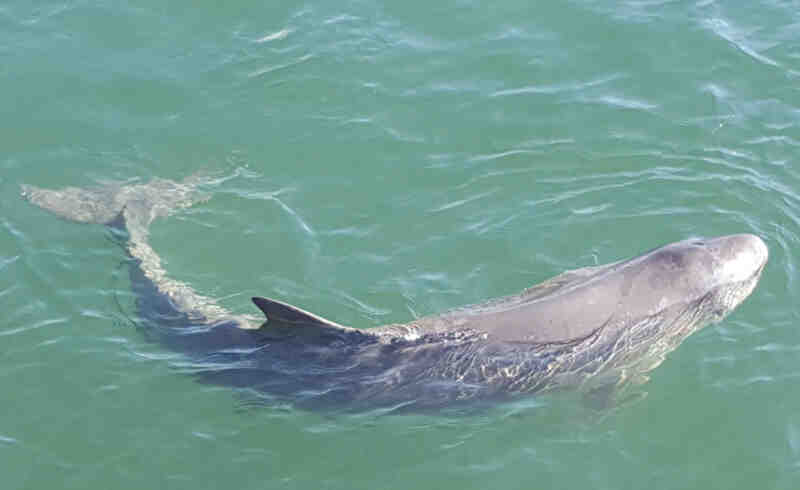Kogia sima
IUCN
LCBasic Information
Scientific classification
- name:Kogia sima
- Scientific Name:Kogia sima,Kogia simus (Owen, 1866),Physeter simus Owen, 1866, Dwarf Sperm Whale, Dwarf Sperm Whale, Cachalot nain, Cachalot nain,Cachalote Enano, Cachalote Enano,,Owen's sperm whale
- Outline:Cetacea
- Family:Odontoceti S.Whale
Vital signs
- length:2.1-2.7m
- Weight:135-270kg
- lifetime:20-30years
Feature
The species was not widely recognized until 1966
Distribution and Habitat
Pygmy sperm whales occur in the temperate and tropical Atlantic, Indian, and Pacific Oceans from about 45°S to 45°N. They are more abundant in tropical and subtropical waters. They are usually most common in shelf breaks and island slope waters. Dietary evidence suggests that these whales feed in deeper waters, diving to 300 meters below the surface.
Appearance
The pygmy sperm whale is compact and streamlined, tapering from the body to the tail. The body length ranges from 2.1 to 2.7 meters, but rarely exceeds 2.5 meters. The weight is 135-270 kg. The skin color ranges from blue-gray, dark gray and dark brown to completely black, with white or light gray on the ventral surface; pink or purple spots may also appear. The upper surface of the flippers and the back of the tail are also iron-gray. The flippers are broad and rounded at the edges, and the tail fin is pointed and 61 cm wide. The dorsal fin is located in the middle of the back and can be used to distinguish individual whales because its shape varies from sickle-shaped to curved and pointed to triangular. The head is approximately square with a conical and pointed snout, and the blowhole is above the eye and offset to the left of the midline of the head, resulting in a significant asymmetry of the skull. The lower jaw is narrow and does not reach the sides of the head, with its front e
Details
Dwarf Sperm Whale, no subspecies.

The species of Dwarf Sperm Whale was not widely recognized until 1966, so it was often unclear in the literature before then which species "Kogia" was targeting. No subspecies of the pygmy sperm whale have been found. However, based on sequencing of the mitochondrial cytochrome b gene, it has been proposed that the pygmy sperm whale consists of two species: one in the Atlantic Ocean and the other in the Indo-Pacific Ocean (Chivers et al., 2005). Further evidence is needed to conclusively prove this (Mc Alpine 2018).
Pygmy sperm whales are timid and rarely approach ships. They appear in small groups of 6-10 or alone, swimming slowly or floating on the water. They always float slowly to the surface of the sea, unlike other whales that roll forward on the surface of the sea, and when entering the water, they also dive directly into the water. When frightened, pygmy sperm whales will release brown-red intestinal fluid before diving, and the intestinal fluid will form a cloud of fog to confuse others. They occasionally jump up and hit the waves, and then enter the water by landing on their tail or belly. These whales do not migrate, but strandings are seasonal in certain areas, which may indicate seasonal changes in distribution. For example, in the northeastern Atlantic, strandings occur mainly in the fall and winter.
The diet of pygmy sperm whales consists mainly of cephalopods, especially squid species Ancistrocheirus lesueurii, species of the family Squididae, Chiroteuthisveranyi, and species of the family Octopus, although fish and crustaceans also form part of the diet. Echolocation may be used to locate prey, as these whales forage in dimly lit areas of the ocean.
Little is known about reproduction in pygmy sperm whales. The mating process is probably similar to that of other cetaceans: when the female and male align their bellies, the male inserts his penis into the female's reproductive tract and fertilizes the ovum internally. The gestation period is nine months, and the duration of the calving season lasts at least five or six months. There is at least one calving peak in the summer. Frequent observations of pregnant females with unweaned calves indicate an annual reproductive cycle of one calf per year. Pygmy sperm whales care for their calves in a similar cetacean manner, with females remaining with their calves for months to years. Females care for and protect their calves. Their ability to excrete feces to distract predators may be considered another means of protecting their offspring.
The population of pygmy sperm whales in the waters around Hawaii is estimated to be around 19,000, but global estimates are lacking.
A small number of pygmy sperm whales have been deliberately captured in poaching in Japan, Indonesia, Taiwan, the Lesser Antilles, and Sri Lanka (Jefferson et al. 1993). However, this removal is thought to be very small-scale. These whales also occasionally die in drift net fisheries in the northern Indian Ocean and in pelagic longline fisheries in the northeast Atlantic. In 2005, an unusual series of strandings occurred in and around Taiwan, China, over a period of about 3 weeks, including 13 pygmy sperm whales. It is unclear whether these strandings were related to military, seismic surveys, or other human activities that generate loud noises. In the southeastern United States, exposure to domoic acid associated with harmful algae has been associated with pygmy sperm whale deaths (Fire et al., 2009). As with most other cetaceans, there is growing evidence that pygmy sperm whales have a tendency to ingest plastic debris (Stamper et al., 2006).
Listed on the IUCN Red List of Threatened Species (IUCN) 2020 ver3.1 - Least Concern (LC).
Listed in Appendix I, II and III of the Convention on International Trade in Endangered Species of Wild Fauna and Flora (CITES) 2019 Edition Appendix II.
Listed in China's National List of Key Protected Wildlife (February 5, 2021) Level II.
Protect wildlife and eliminate game.
Maintaining ecological balance is everyone's responsibility!








